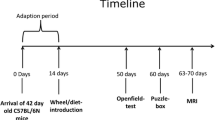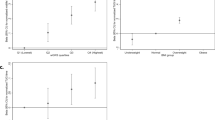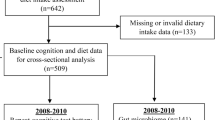Abstract
The dysregulation of trace elements in the brain, which can be caused by genetic or environmental factors, has been associated with disease and compromised mobility. Research regarding trace elements and motor function has focused mainly on the basal ganglia, but few studies have examined the olfactory bulb in this context. Diets high in fat have been shown to have consequences of dysregulated iron and manganese in the brain and disrupted motor activity. The aim of our study was to examine the relationship between mobility and trace element disruption in the olfactory bulb in male and female C57BL/6J and DBA/2J mice fed a high-fat diet. Mobility was significantly reduced in male C57BL/6Js, but the correlation between iron and manganese in the olfactory bulb with velocity, distance travelled, and habituation was not statistically significant. However, there appears to be an overall pattern of a high-fat diet having a statistically significant impact individually on elevated iron and manganese in the olfactory bulb, reduced velocity, reduced distance travelled, and reduced habituation mainly in the male C57BL/6J strain. We found similar trends within the scientific literature to suggest that dysregulated trace element status in the olfactory bulb may be related to motor function in both humans and animals and that males may be more susceptible to the negative outcomes. Our findings contribute new information regarding the impact of diet on the brain, behavior, and potential connection between trace element dysregulation in the olfactory bulb with mobility.



Similar content being viewed by others
Data Availability
Supporting data for this study are available from the corresponding author upon reasonable request.
References
Sandstead HH (2009) Nutrition and Brain Function: Trace Elements. Nutr Rev 44:37–41. https://doi.org/10.1111/j.1753-4887.1986.tb07676.x
Grochowski C, Blicharska E, Krukow P et al (2019) Analysis of Trace Elements in Human Brain: its Aim, methods, and concentration levels. Front Chem 7:115. https://doi.org/10.3389/fchem.2019.00115
Genoud S, Roberts BR, Gunn AP et al (2017) Subcellular compartmentalisation of copper, iron, manganese, and zinc in the Parkinson’s disease brain. Metallomics 9:1447–1455. https://doi.org/10.1039/C7MT00244K
Wandt VK, Winkelbeiner N, Bornhorst J et al (2021) A matter of concern – Trace element dyshomeostasis and genomic stability in neurons. Redox Biol 41:101877. https://doi.org/10.1016/j.redox.2021.101877
Long H, Zhu W, Wei L, Zhao J (2023) Iron homeostasis imbalance and ferroptosis in brain diseases. MedComm 4:e298. https://doi.org/10.1002/mco2.298
Balachandran RC, Mukhopadhyay S, McBride D et al (2020) Brain manganese and the balance between essential roles and neurotoxicity. J Biol Chem 295:6312–6329. https://doi.org/10.1074/jbc.REV119.009453
Mezzaroba L, Alfieri DF, Colado Simão AN, Vissoci Reiche EM (2019) The role of zinc, copper, manganese and iron in neurodegenerative diseases. Neurotoxicology 74:230–241. https://doi.org/10.1016/j.neuro.2019.07.007
Tarnacka B, Jopowicz A, Maślińska M (2021) Copper, Iron, and Manganese Toxicity in Neuropsychiatric Conditions. IJMS 22:7820. https://doi.org/10.3390/ijms22157820
Farina M, Avila DS, Da Rocha JBT, Aschner M (2013) Metals, oxidative stress and neurodegeneration: a focus on iron, manganese and mercury. Neurochem Int 62:575–594. https://doi.org/10.1016/j.neuint.2012.12.006
Chen P, Totten M, Zhang Z et al (2019) Iron and manganese-related CNS toxicity: mechanisms, diagnosis and treatment. Expert Rev Neurother 19:243–260. https://doi.org/10.1080/14737175.2019.1581608
Cristóvão JS, Santos R, Gomes CM (2016) Metals and neuronal metal binding proteins implicated in Alzheimer’s Disease. Oxidative Med Cell Longev 2016:1–13. https://doi.org/10.1155/2016/9812178
Muller M, Leavitt BR (2014) Iron dysregulation in Huntington’s disease. J Neurochem 130:328–350. https://doi.org/10.1111/jnc.12739
Ferreira A, Neves P, Gozzelino R (2019) Multilevel impacts of Iron in the brain: the Cross talk between neurophysiological mechanisms, Cognition, and Social Behavior. Pharmaceuticals 12:126. https://doi.org/10.3390/ph12030126
Zoni S, Lucchini RG (2013) Manganese exposure: cognitive, motor and behavioral effects on children a review of recent findings. Curr Opin Pediatr 25:255–260. https://doi.org/10.1097/MOP.0b013e32835e906b
Chen P, Chakraborty S, Mukhopadhyay S et al (2015) Manganese homeostasis in the nervous system. J Neurochem 134:601–610. https://doi.org/10.1111/jnc.13170
Braak H, Tredici KD, Rüb U et al (2003) Staging of brain pathology related to sporadic Parkinson’s disease. Neurobiol Aging 24:197–211. https://doi.org/10.1016/S0197-4580(02)00065-9
Ubeda-Bañon I, Saiz-Sanchez D, De La Rosa-Prieto C, Martinez-Marcos A (2013) α-Synuclein in the olfactory system in Parkinson’s disease: role of neural connections on spreading pathology. Brain Struct Funct. https://doi.org/10.1007/s00429-013-0651-2
Attems J, Walker L, Jellinger KA (2014) Olfactory bulb involvement in neurodegenerative diseases. Acta Neuropathol 127:459–475. https://doi.org/10.1007/s00401-014-1261-7
Fullard ME, Morley JF, Duda JE (2017) Olfactory dysfunction as an early biomarker in Parkinson’s Disease. Neurosci Bull 33:515–525. https://doi.org/10.1007/s12264-017-0170-x
Gardner B, Dieriks BV, Cameron S et al (2017) Metal concentrations and distributions in the human olfactory bulb in Parkinson’s disease. Sci Rep 7:10454. https://doi.org/10.1038/s41598-017-10659-6
Sen S, Flynn MR, Du G et al (2011) Manganese Accumulation in the olfactory bulbs and other Brain regions of asymptomatic welders. Toxicol Sci 121:160–167. https://doi.org/10.1093/toxsci/kfr033
Vidal R, Miravalle L, Gao X et al (2008) Expression of a mutant form of the Ferritin Light Chain Gene induces neurodegeneration and Iron overload in transgenic mice. J Neurosci 28:60–67. https://doi.org/10.1523/JNEUROSCI.3962-07.2008
Maccarinelli F, Pagani A, Cozzi A et al (2015) A novel neuroferritinopathy mouse model (FTL 498InsTC) shows progressive brain iron dysregulation, morphological signs of early neurodegeneration and motor coordination deficits. Neurobiol Dis 81:119–133. https://doi.org/10.1016/j.nbd.2014.10.023
Liu L, Byrd A, Plummer J et al (2016) The Effects of Dietary Fat and Iron Interaction on Brain Regional Iron contents and stereotypical behaviors in male C57BL/6J mice. https://doi.org/10.3389/fnut.2016.00020. Front Nutr 3:
Han J, Plummer J, Liu L et al (2019) The impact of obesity on brain iron levels and α-synuclein expression is regionally dependent. Nutr Neurosci 22:335–343. https://doi.org/10.1080/1028415X.2017.1387720
Charradi K, Mahmoudi M, Bedhiafi T et al (2017) Dietary supplementation of grape seed and skin flour mitigates brain oxidative damage induced by a high-fat diet in rat: gender dependency. Biomed Pharmacother 87:519–526. https://doi.org/10.1016/j.biopha.2017.01.015
Totten MS, Wallace CW, Pierce DM et al (2022) The impact of a high-fat diet on physical activity and dopamine neurochemistry in the striatum is sex and strain dependent in C57BL/6J and DBA/2J mice. Nutr Neurosci 25:2601–2615. https://doi.org/10.1080/1028415X.2021.1992082
Totten MS, Pierce DM, Erikson KM (2020) Diet-Induced obesity disrupts Trace element Homeostasis and Gene expression in the olfactory bulb. Nutrients 12:3909. https://doi.org/10.3390/nu12123909
Totten MS, Pierce DM, Erikson KM (2021) The influence of sex and strain on trace element dysregulation in the brain due to diet-induced obesity. J Trace Elem Med Biol 63:126661. https://doi.org/10.1016/j.jtemb.2020.126661
Norris KM, Okie W, Kim WK et al (2016) A high-fat diet differentially regulates glutathione phenotypes in the obesity-prone mouse strains DBA/2J, C57BL/6J, and AKR/J. Nutr Res 36:1316–1324. https://doi.org/10.1016/j.nutres.2016.10.004
Montgomery MK, Hallahan NL, Brown SH et al (2013) Mouse strain-dependent variation in obesity and glucose homeostasis in response to high-fat feeding. Diabetologia 56:1129–1139. https://doi.org/10.1007/s00125-013-2846-8
Mozhui K, Karlsson R-M, Kash TL et al (2010) Strain differences in stress responsivity are Associated with Divergent Amygdala Gene expression and glutamate-mediated neuronal excitability. J Neurosci 30:5357–5367. https://doi.org/10.1523/JNEUROSCI.5017-09.2010
Fureix C, Walker M, Harper L et al (2016) Stereotypic behaviour in standard non-enriched cages is an alternative to depression-like responses in C57BL/6 mice. Behav Brain Res 305:186–190. https://doi.org/10.1016/j.bbr.2016.02.005
Kulesskaya N, Karpova NN, Ma L et al (2014) Mixed housing with DBA/2 mice induces stress in C57BL/6 mice: implications for interventions based on social enrichment. Front Behav Neurosci 8. https://doi.org/10.3389/fnbeh.2014.00257
Seibenhener ML, Wooten MC (2015) Use of the Open Field maze to measure locomotor and anxiety-like behavior in mice. JoVE 52434. https://doi.org/10.3791/52434
Gellért L, Varga D (2016) Locomotion activity measurement in an Open Field for mice. https://doi.org/10.21769/BioProtoc.1857. BIO-PROTOCOL 6:
Krishna S, Lin Z, De La Serre CB et al (2016) Time-dependent behavioral, neurochemical, and metabolic dysregulation in female C57BL/6 mice caused by chronic high-fat diet intake. Physiol Behav 157:196–208. https://doi.org/10.1016/j.physbeh.2016.02.007
Bridgewater LC, Zhang C, Wu Y et al (2017) Gender-based differences in host behavior and gut microbiota composition in response to high fat diet and stress in a mouse model. Sci Rep 7:10776. https://doi.org/10.1038/s41598-017-11069-4
Almeida-Suhett CP, Scott JM, Graham A et al (2019) Control diet in a high-fat diet study in mice: regular chow and purified low-fat diet have similar effects on phenotypic, metabolic, and behavioral outcomes. Nutr Neurosci 22:19–28. https://doi.org/10.1080/1028415X.2017.1349359
Ward RJ, Zucca FA, Duyn JH et al (2014) The role of iron in brain ageing and neurodegenerative disorders. Lancet Neurol 13:1045–1060. https://doi.org/10.1016/S1474-4422(14)70117-6
Aaseth J, Dusek P, Roos PM (2018) Prevention of progression in Parkinson’s disease. Biometals 31:737–747. https://doi.org/10.1007/s10534-018-0131-5
Hopfner F, Hobert MA, Maetzler C et al (2019) Mobility deficits assessed with Mobile Technology: what can we learn from brain Iron-altered animal. Models? Front Neurol 10:833. https://doi.org/10.3389/fneur.2019.00833
Kumar N, Rizek P, Sadikovic B et al (2016) Movement Disorders Associated with hemochromatosis. Can J Neurol Sci 43:801–808. https://doi.org/10.1017/cjn.2016.286
Loughnan R, Ahern J, Tompkins C et al (2022) Association of genetic variant linked to hemochromatosis with brain magnetic resonance imaging measures of Iron and Movement Disorders. JAMA Neurol 79:919. https://doi.org/10.1001/jamaneurol.2022.2030
Touarsa F, Ali Mohamed D, Onka B et al (2022) Brain iron accumulation on MRI revealing aceruloplasminemia: a rare cause of simultaneous brain and systemic iron overload. BJR|case Rep 8:20220035. https://doi.org/10.1259/bjrcr.20220035
Normandin L, Panisset M, Zayed J (2002) Manganese neurotoxicity: behavioral, pathological, and biochemical Effects following various routes of exposure. Rev Environ Health 17. https://doi.org/10.1515/REVEH.2002.17.3.189
Jenkitkasemwong S, Akinyode A, Paulus E et al (2018) SLC39A14 deficiency alters manganese homeostasis and excretion resulting in brain manganese accumulation and motor deficits in mice. Proc Natl Acad Sci USA 115. https://doi.org/10.1073/pnas.1720739115
Nam J, Kim K (2008) Abnormal motor function and the expression of Striatal dopamine D2 receptors in manganese-treated mice. Biol Pharm Bull 31:1894–1897. https://doi.org/10.1248/bpb.31.1894
Alaverdashvili M, Lapointe V, Whishaw IQ, Cross AR (2017) Manganese-enhanced magnetic resonance imaging and studies of rat behavior: transient motor deficit in Skilled reaching, rears, and activity in rats after a single dose of MnCl 2. Magn Reson�Insights 10:1178623X1770687. https://doi.org/10.1177/1178623X17706878
Ferreira SA, Loreto JS, Dos Santos MM, Barbosa NV (2022) Environmentally relevant manganese concentrations evoke anxiety phenotypes in adult zebrafish. Environ Toxicol Pharmacol 93:103870. https://doi.org/10.1016/j.etap.2022.103870
Schneider JS, Decamp E, Koser AJ et al (2006) Effects of chronic manganese exposure on cognitive and motor functioning in non-human primates. Brain Res 1118:222–231. https://doi.org/10.1016/j.brainres.2006.08.054
Bolivar VJ (2009) Intrasession and intersession habituation in mice: from inbred strain variability to linkage analysis. Neurobiol Learn Mem 92:206–214. https://doi.org/10.1016/j.nlm.2009.02.002
Zhao F, Wang X, Zariwala HA et al (2016) fMRI study of olfaction in the olfactory bulb and high olfactory structures of rats: insight into their roles in habituation. NeuroImage 127:445–455. https://doi.org/10.1016/j.neuroimage.2015.10.080
Fredriksson A, Schröder N, Eriksson P et al (2000) Maze learning and motor activity deficits in adult mice induced by iron exposure during a critical postnatal period. Dev Brain Res 119:65–74. https://doi.org/10.1016/S0165-3806(99)00160-1
Sobotka TJ, Whittaker P, Sobotka JM et al (1996) Neurobehavioral dysfunctions associated with dietary iron overload. Physiol Behav 59:213–219. https://doi.org/10.1016/0031-9384(95)02030-6
Dziewulska D, Doi H, Fasano A et al (2013) Olfactory impairment and pathology in neurodegenerative disorders with brain iron accumulation. Acta Neuropathol 126:151–153. https://doi.org/10.1007/s00401-013-1136-3
Foster ML, Bartnikas TB, Maresca-Fichter HC et al (2018) Neonatal C57BL/6J and parkin mice respond differently following developmental manganese exposure: result of a high dose pilot study. Neurotoxicology 64:291–299. https://doi.org/10.1016/j.neuro.2017.10.002
Foster ML, Bartnikas TB, Maresca-Fichter HC et al (2017) Interactions of manganese with iron, zinc, and copper in neonatal C57BL/6J and parkin mice following developmental oral manganese exposure. Data in Brief 15:908–915. https://doi.org/10.1016/j.dib.2017.10.050
Dorman DC, McManus BE, Marshall MW et al (2004) Old age and gender influence the pharmacokinetics of inhaled manganese sulfate and manganese phosphate in rats. Toxicol Appl Pharmcol 197:113–124. https://doi.org/10.1016/j.taap.2004.02.010
Betharia S, Maher TJ (2012) Neurobehavioral effects of lead and manganese individually and in combination in developmentally exposed rats. Neurotoxicology 33:1117–1127. https://doi.org/10.1016/j.neuro.2012.06.002
Aydemir TB, Kim M-H, Kim J et al (2017) Metal Transporter Zip14 (Slc39a14) Deletion in Mice Increases Manganese Deposition and Produces Neurotoxic Signatures and Diminished Motor Activity. J Neurosci 37:5996–6006. https://doi.org/10.1523/JNEUROSCI.0285-17.2017
Spence RD, Hamby ME, Umeda E et al (2011) Neuroprotection mediated through estrogen receptor-α in astrocytes. Proc Natl Acad Sci USA 108:8867–8872. https://doi.org/10.1073/pnas.1103833108
Acknowledgements
The authors acknowledge Paula Cooney for assistance with tissue collection and Mary Martinez for assistance with animal care.
Funding
This research was funded by the UNC Greensboro Health and Human Sciences Research Grant and Faculty First Award.
Author information
Authors and Affiliations
Contributions
All authors contributed to the preparation and review of this manuscript. All authors read and approved the final manuscript.
Corresponding author
Ethics declarations
Competing Interests
The authors declare no competing interests.
Ethics Approval
This study was conducted in an American Association for Laboratory Animal Care accredited facility following a protocol approved by the Institution of Animal Care and Use Committee at the University of North Carolina Greensboro (protocol #18 − 001). Procedures were performed by the principles and guidelines established by the National Institutes of Health for the ethical care and use of laboratory animals.
Additional information
Publisher’s Note
Springer Nature remains neutral with regard to jurisdictional claims in published maps and institutional affiliations.
Rights and permissions
Springer Nature or its licensor (e.g. a society or other partner) holds exclusive rights to this article under a publishing agreement with the author(s) or other rightsholder(s); author self-archiving of the accepted manuscript version of this article is solely governed by the terms of such publishing agreement and applicable law.
About this article
Cite this article
Totten, M.S., Howell, J.M., Tomberlin, J.A. et al. Relationship Between a High-Fat Diet, Reduced Mobility, and Trace Element Overload in the Olfactory Bulbs of C57BL/6J and DBA/2J Mice. Biol Trace Elem Res 202, 3215–3224 (2024). https://doi.org/10.1007/s12011-023-03911-w
Received:
Accepted:
Published:
Issue Date:
DOI: https://doi.org/10.1007/s12011-023-03911-w




